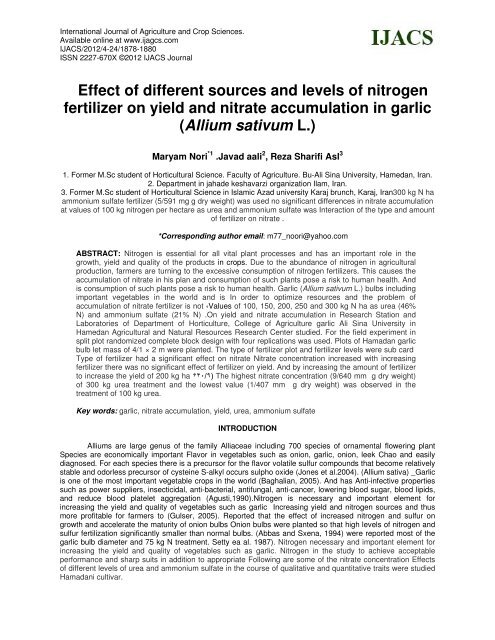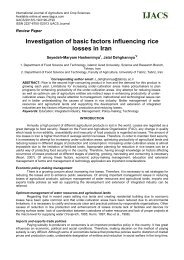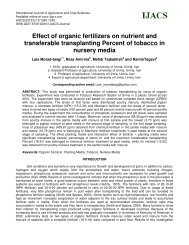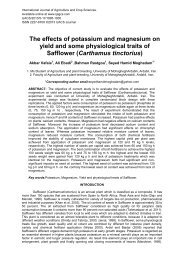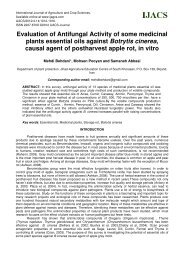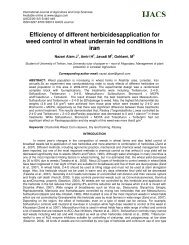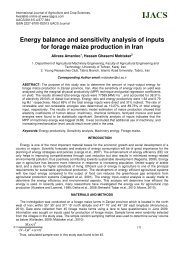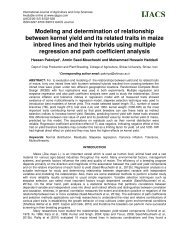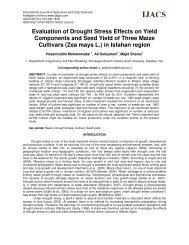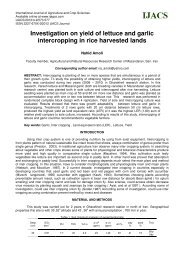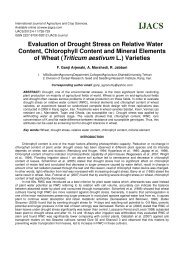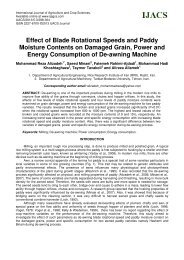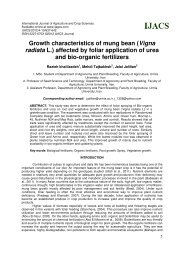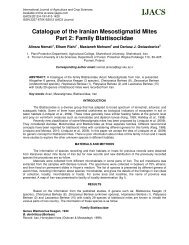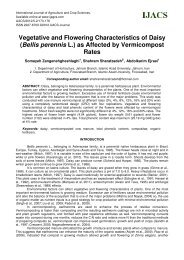Allium sativum L. - International Journal of Agriculture and Crop ...
Allium sativum L. - International Journal of Agriculture and Crop ...
Allium sativum L. - International Journal of Agriculture and Crop ...
Create successful ePaper yourself
Turn your PDF publications into a flip-book with our unique Google optimized e-Paper software.
<strong>International</strong> <strong>Journal</strong> <strong>of</strong> <strong>Agriculture</strong> <strong>and</strong> <strong>Crop</strong> Sciences.<br />
Available online at www.ijagcs.com<br />
IJACS/2012/4-24/1878-1880<br />
ISSN 2227-670X ©2012 IJACS <strong>Journal</strong><br />
Effect <strong>of</strong> different sources <strong>and</strong> levels <strong>of</strong> nitrogen<br />
fertilizer on yield <strong>and</strong> nitrate accumulation in garlic<br />
(<strong>Allium</strong> <strong>sativum</strong> L.)<br />
Maryam Nori *1 .Javad aali 2 , Reza Sharifi Asl 3<br />
1. Former M.Sc student <strong>of</strong> Horticultural Science. Faculty <strong>of</strong> <strong>Agriculture</strong>. Bu-Ali Sina University, Hamedan, Iran.<br />
2. Department in jahade keshavarzi organization Ilam, Iran.<br />
3. Former M.Sc student <strong>of</strong> Horticultural Science in Islamic Azad university Karaj brunch, Karaj, Iran300 kg N ha<br />
ammonium sulfate fertilizer (5/591 mg g dry weight) was used no significant differences in nitrate accumulation<br />
at values <strong>of</strong> 100 kg nitrogen per hectare as urea <strong>and</strong> ammonium sulfate was Interaction <strong>of</strong> the type <strong>and</strong> amount<br />
<strong>of</strong> fertilizer on nitrate .<br />
*Corresponding author email: m77_noori@yahoo.com<br />
ABSTRACT: Nitrogen is essential for all vital plant processes <strong>and</strong> has an important role in the<br />
growth, yield <strong>and</strong> quality <strong>of</strong> the products in crops. Due to the abundance <strong>of</strong> nitrogen in agricultural<br />
production, farmers are turning to the excessive consumption <strong>of</strong> nitrogen fertilizers. This causes the<br />
accumulation <strong>of</strong> nitrate in his plan <strong>and</strong> consumption <strong>of</strong> such plants pose a risk to human health. And<br />
is consumption <strong>of</strong> such plants pose a risk to human health. Garlic (<strong>Allium</strong> <strong>sativum</strong> L.) bulbs including<br />
important vegetables in the world <strong>and</strong> is In order to optimize resources <strong>and</strong> the problem <strong>of</strong><br />
accumulation <strong>of</strong> nitrate fertilizer is not Values <strong>of</strong> 100, 150, 200, 250 <strong>and</strong> 300 kg N ha as urea (46%<br />
N) <strong>and</strong> ammonium sulfate (21% N) On yield <strong>and</strong> nitrate accumulation in Research Station <strong>and</strong><br />
Laboratories <strong>of</strong> Department <strong>of</strong> Horticulture, College <strong>of</strong> <strong>Agriculture</strong> garlic Ali Sina University in<br />
Hamedan Agricultural <strong>and</strong> Natural Resources Research Center studied For the field experiment in<br />
split plot r<strong>and</strong>omized complete block design with four replications was used. Plots <strong>of</strong> Hamadan garlic<br />
bulb let mass <strong>of</strong> 4/1 × 2 m were planted The type <strong>of</strong> fertilizer plot <strong>and</strong> fertilizer levels were sub card<br />
Type <strong>of</strong> fertilizer had a significant effect on nitrate Nitrate concentration increased with increasing<br />
fertilizer there was no significant effect <strong>of</strong> fertilizer on yield. And by increasing the amount <strong>of</strong> fertilizer<br />
to increase the yield <strong>of</strong> 200 kg ha The highest nitrate concentration (9/640 mm g dry weight)<br />
<strong>of</strong> 300 kg urea treatment <strong>and</strong> the lowest value (1/407 mm g dry weight) was observed in the<br />
treatment <strong>of</strong> 100 kg urea.<br />
Key words: garlic, nitrate accumulation, yield, urea, ammonium sulfate<br />
INTRODUCTION<br />
<strong>Allium</strong>s are large genus <strong>of</strong> the family Alliaceae including 700 species <strong>of</strong> ornamental flowering plant<br />
Species are economically important Flavor in vegetables such as onion, garlic, onion, leek Chao <strong>and</strong> easily<br />
diagnosed. For each species there is a precursor for the flavor volatile sulfur compounds that become relatively<br />
stable <strong>and</strong> odorless precursor <strong>of</strong> cysteine S-alkyl occurs sulpho oxide (Jones et al.2004). (<strong>Allium</strong> sativa) _Garlic<br />
is one <strong>of</strong> the most important vegetable crops in the world (Baghalian, 2005). And has Anti-infective properties<br />
such as power suppliers, insecticidal, anti-bacterial, antifungal, anti-cancer, lowering blood sugar, blood lipids,<br />
<strong>and</strong> reduce blood platelet aggregation (Agusti,1990).Nitrogen is necessary <strong>and</strong> important element for<br />
increasing the yield <strong>and</strong> quality <strong>of</strong> vegetables such as garlic Increasing yield <strong>and</strong> nitrogen sources <strong>and</strong> thus<br />
more pr<strong>of</strong>itable for farmers to (Gulser, 2005). Reported that the effect <strong>of</strong> increased nitrogen <strong>and</strong> sulfur on<br />
growth <strong>and</strong> accelerate the maturity <strong>of</strong> onion bulbs Onion bulbs were planted so that high levels <strong>of</strong> nitrogen <strong>and</strong><br />
sulfur fertilization significantly smaller than normal bulbs. (Abbas <strong>and</strong> Sxena, 1994) were reported most <strong>of</strong> the<br />
garlic bulb diameter <strong>and</strong> 75 kg N treatment. Setty ea al. 1987). Nitrogen necessary <strong>and</strong> important element for<br />
increasing the yield <strong>and</strong> quality <strong>of</strong> vegetables such as garlic. Nitrogen in the study to achieve acceptable<br />
performance <strong>and</strong> sharp suits in addition to appropriate Following are some <strong>of</strong> the nitrate concentration Effects<br />
<strong>of</strong> different levels <strong>of</strong> urea <strong>and</strong> ammonium sulfate in the course <strong>of</strong> qualitative <strong>and</strong> quantitative traits were studied<br />
Hamadani cultivar.
Intl J Agri <strong>Crop</strong> Sci. Vol., 4 (24), 1878-1880, 2012<br />
MATERIALS AND METHODS<br />
Operation <strong>of</strong> this project during 1387 – 1386 (2007-2008) at the Research Farm, Department <strong>of</strong><br />
Horticulture, Faculty <strong>of</strong> <strong>Agriculture</strong>, University <strong>of</strong> Bu Ali Sina Factor split plot experiment with two levels <strong>of</strong><br />
fertilizers (urea <strong>and</strong> ammonium sulfate) <strong>and</strong> sub factor <strong>of</strong> five fertilizer levels (100, 150, 200, 250 <strong>and</strong> 300 kg N<br />
ha) in a complete block design four replications were r<strong>and</strong>omized After providing the white variety bulb were<br />
planted plot Hamadani in the seventh row spacing 20 cm between rows <strong>and</strong> 10 cm within the rows Total<br />
nitrogen fertilizer treatments were equally divided <strong>and</strong> allocated to each plot twice what was January phenol<br />
sulfonic acid nitrate colorimetric assay was performed. Data recorded are analysis by using MSTAT-C s<strong>of</strong>tware,<br />
was used for statistical analysis Comparison <strong>of</strong> means was performed using Duncan <strong>and</strong> graphs were plotted<br />
using Excel s<strong>of</strong>tware.<br />
RESULTS AND DUSCATION<br />
Effect <strong>of</strong> fertilizer on nitrate levels<br />
The comparison results (Table 1) Type <strong>of</strong> fertilizer had different effects on nitrate accumulation in garlic<br />
<strong>and</strong> garlic with the highest concentration <strong>of</strong> nitrate fertilizer applied urea compared to ammonium sulfate<br />
treatment was rate increased, increased nitrate The was highest amount <strong>of</strong> nitrate in the treatment <strong>of</strong> 300 kg N<br />
ha urea (9/640 mm g dry weight) The average time that was more than accumulation was significantly so that<br />
both urea <strong>and</strong> ammonium sulfate concentrations between 100 <strong>and</strong> 150 kg N/h nitrate concentrations were not<br />
significantly different from Although the amounts <strong>of</strong> nitrogen Nitrate accumulation in plants fed with urea was<br />
significantly higher Khodabakhshzadeh, 2001 Reported that with increasing amounts <strong>of</strong> urea nitrate<br />
concentration increased in the course (R<strong>and</strong>le, 2000). He reported nitrate concentration in onion bulbs grown in<br />
solution increased with increasing nitrogen Jones et al, 2004) In a survey showed on onion Increasing nitrogen<br />
fertilizer increased nitrate concentration in onion bulbs were Between the two types <strong>of</strong> urea <strong>and</strong> ammonium<br />
sulfate at doses <strong>of</strong> 100 <strong>and</strong> 150 kg N/h nitrate concentrations were not significantly different from Although the<br />
amounts <strong>of</strong> nitrogen Nitrate accumulation in plants fed with urea was significantly higher. This may be because<br />
Ammonium sulfate fertilizer low in nitrogen allocated to the production <strong>of</strong> cysteine <strong>and</strong> the production <strong>of</strong> large<br />
amounts <strong>of</strong> fertilizer, high nitrate concentration is low cysteine.<br />
Table 1. Comparison <strong>of</strong> mean for different <strong>of</strong> levels nitrogen fertilizer <strong>and</strong> interaction effect on nitrate accumulation <strong>and</strong> yield <strong>of</strong><br />
garlic<br />
Kg/ha Nitrate<br />
Treatments<br />
(Mg/kg Dw)<br />
(kg N/ha)<br />
1387/03a 515/4b<br />
Ammonium<br />
sulphate<br />
13790/24a 517/1a Urea<br />
13370e 410/1e 100 kg N/ha<br />
14740b 439/7d 150 kg N/ha<br />
16620a 502/5c 200 kg N/ha<br />
12930c 534/7b 250 kg N/ha<br />
11530d 616/2a 300 kg N/ha<br />
13270d 414/2h AS 100<br />
14570c 439/6g AS 150<br />
17050a 473/8f AS 200<br />
13120d 503/5e AS 250<br />
11430e 591/5b AS 300<br />
13470d 407/6h U 100<br />
14920c 439/8g U 150<br />
16180b 531/1d U 200<br />
12740d 565/8c U 250<br />
11430e 640/9a U 300<br />
Different letters in each column show significant differences at 1 level <strong>of</strong> probability using DMRT<br />
Effect <strong>of</strong> fertilizer levels on the yield <strong>of</strong> garlic<br />
Fertilizer levels had no significant effect on the course <strong>of</strong> action by increasing the amount <strong>of</strong> fertilizer to<br />
increase the yield <strong>of</strong> 200 kg N/h. And then increased with the application <strong>of</strong> 300 kg N/h decreased The highest<br />
yield is obtained (16,620 kg) 200 kg N treatment <strong>and</strong> the lowest (11,530 kg per hectare) in the treatment <strong>of</strong> 300<br />
kg N. (Khodabakhshzadeh, 2001) showed a trend yield increase <strong>of</strong> 180 kg urea <strong>and</strong> the amounts <strong>of</strong> garlic yield<br />
decreased to 300 kg N/h. (Sardi <strong>and</strong> Timer, 2005) Showed that garlic, especially in the early stages <strong>of</strong> growth<br />
will require high nitrogen. The highest yield was obtained in the treatment <strong>of</strong> 300 kg N/h. (Gaviola <strong>and</strong><br />
Lipinski2008). Course yield at 225 kg N ha treatment reported (R<strong>and</strong>le, 2000). In one study showed that the<br />
onion Granyks Amounts <strong>of</strong> nitrogen fertilizer treatments (22, 78 <strong>and</strong> 97 grams per liter <strong>of</strong> ammonium<br />
1879
Intl J Agri <strong>Crop</strong> Sci. Vol., 4 (24), 1878-1880, 2012<br />
nitrate) with increasing amounts <strong>of</strong> soluble nitrogen, yield <strong>and</strong> bulb weight increased And levels above 78 g<br />
weight <strong>and</strong> bulb firmness decreased. (Lurie, 2005) Reported was that the maximum yield <strong>of</strong> 225 kg per hectare<br />
<strong>of</strong> nitrogen treatment Argentine garlic cultivars. (Buwalda, 1986 The effect <strong>of</strong> different amounts <strong>of</strong> nitrogen<br />
fertilizer showed between zero to 240 kg/h Treatment had the highest yield <strong>of</strong> 120 kg N/h Produced the best<br />
quality garlic Increase process yield up to 200 kg/h will be required to plant nitrogen levels for the<br />
development <strong>of</strong> leaf area <strong>and</strong> net uptake attributed<br />
CONCLUSION<br />
In experiments carried out with increasing amounts <strong>of</strong> urea nitrate <strong>and</strong> ammonium sulfate fertilizer<br />
increased According to the results 200 kg N ha ammonium sulfate fertilizer treatment because garlic is<br />
recommended for high performance <strong>and</strong> low nitrate concentration.<br />
REFRENCES<br />
Agusti KT. 1990. Therapeutic <strong>and</strong> Medicinal Values <strong>of</strong> Onions <strong>and</strong> Garlic .p: 99-104. In Brewster, J. L <strong>and</strong> Rabinowitvh, H. D. eds)<br />
Onions <strong>and</strong> Allied <strong>Crop</strong>s. V. 3. CRC Press, Inc.<br />
Baghalian K, Ziai SA, Naghavi M R, Naghdi Abadi H, Khalighi A. 2005. Evaluation <strong>of</strong> alliicin content <strong>and</strong> botanical traits in Iranian garlic<br />
(<strong>Allium</strong> <strong>sativum</strong> L) Ecotypes. Sci. Hort. 103: 155-166.<br />
Brewster JL, Rabinowitvh H D. Onions <strong>and</strong> Allied <strong>Crop</strong>s. V. 3. CRC Press, Inc. pp. 99-104.<br />
Buwalda JG. 1986. Nitrogen nutrition <strong>of</strong> garlic (<strong>Allium</strong> <strong>sativum</strong> L.) under irrigation components <strong>of</strong> yield <strong>and</strong> indices <strong>of</strong> crop nitrogen<br />
status. Sci. Hort. Pp: 2666-76. Abs.<br />
Gaviola S, Lipinski VM. 2008. Effect <strong>of</strong> nitrogen fertilization on yield <strong>and</strong> color <strong>of</strong> red garlic (<strong>Allium</strong> <strong>sativum</strong>) cultivars. Cien. Inv. Agr. 35(1):<br />
57-64.<br />
Gulser F. 2005. Effects <strong>of</strong> Ammonium Sulphate <strong>and</strong> Urea on NO3- <strong>and</strong> NO2- accumulation, nutrient contents <strong>and</strong> yield criteria in spinach.<br />
J. Scientia Horticulture. 106: 330-340.<br />
Humphries EC. 1956. Mineral components <strong>and</strong> Ash analysis. In: Modern Method <strong>of</strong> plant analysis. Spinger velay. Berlin. V. 7. 468-502.<br />
peach, K <strong>and</strong> Tracy, M. V. eds. Spr. Veriag, Berlin.<br />
Jones MG, Hughes J, Tregova A, Milne J, Tomsett AB, Collin HA. 2004. Biosynthesis <strong>of</strong> the flavor precursors <strong>of</strong> onion <strong>and</strong> garlic”. J.<br />
Experimental Botany. 55 (404):1903-1918.<br />
Khodabakhshzadeh A. 2001. Effect <strong>of</strong> different levels <strong>of</strong> nitrogen on growth <strong>and</strong> development, yield <strong>and</strong> nitrate accumulation in three<br />
cultivars <strong>of</strong> garlic. M.Sc. Thesis <strong>of</strong> Horticultural Science. Islamic Azad University. Science <strong>and</strong> Research Unit.<br />
Lorenz OA. 1976. Potential nitrate levels in edible plant part. Acta. Hort. V. 285. pp. 345-356.<br />
Lurie S. 2005. The Effect <strong>of</strong> high temperature treatment on quality <strong>of</strong> fruits <strong>and</strong> vegetables. ISHS. Acta. Horti. 721. Abs.<br />
R<strong>and</strong>le WM. 2000. Increasing nitrogen concentration in hydroponic solution affects onion flavor <strong>and</strong> bulb quality. J. Amer. Soc. Hort. Sci..<br />
125: 254-259.<br />
Sardi k, Timar E. 2005. Response <strong>of</strong> garlic (<strong>Allium</strong> <strong>sativum</strong> L.) to varying fertilization levels <strong>and</strong> nutrient ratios. Communication in Soil<br />
Science <strong>and</strong> Plant Analysis. 36: 673-679.<br />
1880


